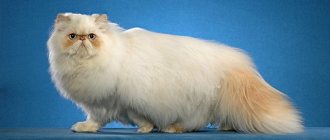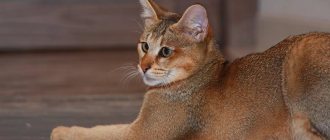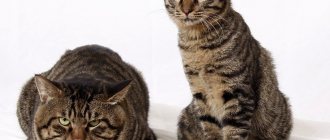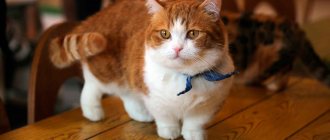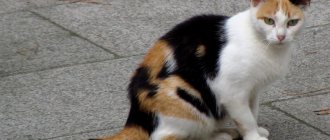Today, Savannah cats are the largest hybrid representatives of the cat family. The roots of the African serval have endowed the savannah not only with its size, but also with its amazing wild color. It is very difficult to meet such a cat in a friend’s house, because you will have to pay a large sum for its wild beauty. It is the Savannah that is passed off as a unique breed of Asher cat.
In the article we will tell you what the Savannah breed is and the history of its origin, what is the character and description of the appearance of this cat with wild ancestors. And also whether it is possible to buy a kitten in Russia and its price.
Origin story
People have always dreamed of taming a wild beast and making it eat from human hands. In the case of the Savannah, an experiment was carried out: an African serval was crossed with a Siamese cat. One female kitten was born. The female was named Savannah, and later the new breed was also named. The cat had daddy's ears, spots on her body and the same appearance.
Three years later, Savannah gave birth to several babies from an Angora cat. They began to be considered representatives of the second generation - F2.
Patrick Kelly joined the work on the breed. He attracted Bengal cats to breeding, and in 1996 he presented a new breed to the International Cat Association. The breed received its own standard, and in 2011 it was officially recognized.
It’s hard to believe, but a Savannah kitten costs as much as a car – 500-600 thousand. And not of the highest class either! And individuals of the F1 category are purebred, with a truly wild appearance and large sizes - a million or even more. It is clear that not everyone can afford such a purchase.
This matter was not without a major scandal. A certain Simon Brody created the company Lifestyle Pets and publicly announced that through his efforts a new breed of cat had appeared - the Asher. The name of the cats was given in honor of the name of the Western Semitic goddess, signifying nature and life. This breed is supposedly completely hypoallergenic, and was created by crossing a leopard cat from Asia, an African serval and a domestic cat.
The scammer paid for a study (which, however, was never published by any major publication), which praised the new genetic experiment and described in detail the process and the advantages of the new breed.
A line of wealthy Americans lined up for the cats, ready to buy the rare breed. However, the myth was soon debunked. Breeder Chris Shirk officially stated at the conference that these Ushers are Savannah cats purchased from him. Dutch geneticists, after conducting research, rendered their verdict: there is no new breed and there cannot be. A huge scandal broke out, and the Lifestyle Pets company ceased to exist.
Savannah breed cost
Savannah breed
The price of Savannah F1 ranges from approximately 400,000 to 1,000,000 rubles. On the European market, the cost of this breed varies from $7,500 to $22,000. However, I have seen advertisements from nurseries for 200,000 thousand rubles, but in such cases I still advise you to consult professionals, since some breeders pass off third-generation Savannahs as F1 offspring. Be careful!
According to the latest data, prices for Savannah cats are as follows: Savannah males:
- F1 from $7,500 to $22,000
- F2 from $4,500 to $16,000
- F3 from $3,000 to $6,000
Savannah females:
- F1 from $6,000 to $22,000
- F2 from $4,500 to $14,000
- F3 from $3,500 to $5,500
In European and American catteries, most kittens will be sterilized before sale unless they are specifically intended for breeding. Kittens sold for breeding usually cost slightly more than those purchased solely as pets. The author of the article does not know the rules for the sale of Savannah cats in Russia, Ukraine and other CIS countries.
Why are savannas expensive?
Savannah F1
People often ask why the Savannah cat is so expensive. Understanding the breeding challenges of this breed will help you appreciate just how special your new pet is.
It often happens to breeders that it takes a lot of time and money to find cats suitable for breeding. A breeder may have to go through many females before a Serval cat recognizes a female as suitable for mating. The gestation period, which is about two weeks less than that of the Serval, is also a problem. Kittens may be born prematurely and require extra care to survive and remain healthy.
Some breeders report that premature births are common in early generations. Savannah kittens may also be too big to give birth naturally and require a C-section!
Savannah litters also tend to have a minimum survival rate of 0-3 kittens. Breeders may have spent as much as $100,000 before their first viable kitten is born and ready for a healthy life.
Standards
Savannah is a large breed. Males and females have no obvious differences. The weight of an individual can be 13-14 kg, and its length can reach a whole meter!
| Standard | Description |
| Head | Small, with an extended muzzle. The cheekbones (like the cheeks) do not stand out, but the large nose and wide bridge of the nose catch the eye. The tip of the nose is black, red or brown. |
| Neck | Wide, muscular, but graceful. |
| Eyes | Large, deep-set, set slightly obliquely. Dark droplet-shaped marks are visible in the inner corners. The iris can be any shade of green or yellow. |
| Ears | Huge, placed high and close to each other. The auricle is open, abundantly furred from the inside (but the hair there is short), the tip of the ear is rounded. |
| Torso | Sturdy, elongated, strong. The chest is wide, the pelvis is noticeably narrower than the shoulder girdle. |
| Limbs | Both the hind and forelimbs are long and slender, with clearly defined muscles. The paws are semicircular, the hind legs are larger than the front ones. The fingers are large and elongated, the claws are also large and hard. |
| Tail | Medium thickness, slightly tapering towards the end, bright color. |
| Wool | The coat can be either very short or medium length. The undercoat is present: it is dense and soft to the touch. The main hair is coarse and hard. |
Savannah cats are divided into 4 groups:
- F1 – in these individuals there is an equal ratio of “wild” and “domestic” genes: i.e. kittens were born as a result of the mating of a domestic cat and an African serval.
- F2 – kittens were born from the connection of a domestic male and an F1 cat.
- F3 – wild genes (serval) – approximately 13-15% (male – domestic cat, female – F2).
- F4 and F5 - born from the mixing of a domestic cat and a hybrid F3. They are similar in size to a regular cat and are gentler in nature than their relatives.
The first generation of cats was very aggressive, so many experts believed that they should not be kept in the house. In some states of America and in Australia, F1 cats have been completely banned. In the rest, a test system is used: the kitten is tested for its relationship to a person. If he shows aggression, he is euthanized.
Expert opinion
Dusheba Vera Ivanovna
In 2010, she graduated from the Moscow State Academy of Veterinary Medicine named after K.I. Scriabin with honors, specializing in veterinary medicine. I regularly attend veterinary conferences, congresses, and webinars.
It is better not to buy savannahs secondhand: you risk getting a kitten of the wrong class for a higher price, or a wild and unsociable kitten. Be sure to check your pedigree, living conditions, vaccinations - this is a must! The baby must react adequately to what is happening and be interested in it, not be afraid of hands and toys extended to him, be able to play, wash himself and do his business in the tray. The optimal age for purchase is 3-4 months.
Genetics
When studying the genetics of a savannah, special terminology is used to determine how many generations it is removed from its serval ancestor.
Each generation is marked with the letter F with a serial number:
- F1 = 1st generation from an African Serval parent (has 50% Serval blood);
- F2 = 2nd generation with Serval grandparent (25% Serval);
- F3 = 3rd generation with Serval great-great-grandparents (12.5% Serval).
The following generations are designated using a similar principle, ending with F7. Then if the female is crossed again with a Serval, the Savannah kitten will have 75% of the father's blood and will inherit his appearance. Females are fertile from the 1st generation, male descendants are infertile until the 5th generation (F5), they are kept as pets. Individuals allowed to breed are very selective, mating only with those with whom they are raised from infancy.
Colors
The standard allows 4 colors:
- Silver spotted.
- Black.
- Black smoky.
- Brownie tabby spotted.
The spots on the skin are black or dark brown. There should be contrasting stripes on the back (from the back of the head to the shoulder blades).
In the photo there are Savannah breed windows of popular colors: silver spotted, black smoky, brown tabby spotted
Nurseries
With the increasing popularity of the Savannah breed, the number of breeders is growing. However, it is recommended to buy a kitten from certified nurseries that are responsible for its pedigree.
32 catteries around the world are officially registered with the International Cat Association (TICA):
- 22 of which are in the USA;
- 4 – in Canada
- 6 are located in European countries: Czech Republic (SAVANNAHCZ), Germany (DANUWA), Great Britain (TOPCATSUK), Scotland (STYLISTICAT), Poland (THECATSAMONGUS), Russia (SAVANNAHGRIFFIN).
There are currently relatively few recorded Savannahs in the world, making them very special pets.
In some places, a ban on owning a Savannah cat has been introduced due to its hybrid origin. This restriction applies in Australia, as well as in some American states, including Nebraska, New Hampshire, Massachusetts, Texas, Hawaii, New York.
Character and behavior
These impeccable beauties are not the usual domestic cats that we can cuddle and knead while sitting on the sofa. Of course, many years of work with the breed has left its mark: Savannahs do not have the same aggressiveness of their ancestors and fear of humans. However, remember: the character of this breed will have to be taken into account, and raising a kitten should begin as soon as it opens its eyes.
Savannahs are born leaders who do not want to give up their leadership to anyone. If you want to remain the leader, you will have to behave accordingly, not be afraid and not give the animal permission for pranks. Castration and sterilization by age help make the animal more docile and calm, but you still won’t get an obedient fluffy.
Active savannas are ready to rush around the house for days, inventing more and more new activities for themselves. This cat cannot be locked in a cramped apartment: it will literally begin to go crazy.
A spacious house with a plot where the cat can run around as much as it likes is the only option. And you will have to walk with her like with a dog: once a day, or even more often.
Savannah is wary of strangers. It won’t hiss or throw, but it won’t go into your hands either. It will take a long time to earn a good attitude on her part.
The hunting instinct of Savannah cats does not subside until old age, and the animal does not hesitate to hone its skills on family members. This should be stopped immediately, otherwise, as the savannah matures, it will not give you rest by jumping around corners and scratching. For the same reason, you will not be able to have any other pet at home. In any case, the savannah will not tolerate any birds, small rodents or other cats. A large dog that can intimidate the savannah – that’s all right.
Cats are more loyal to children, but it is better not to take them into a home with very young children: the Savannah does not always know how (and even wants) to count on its strength, and can seriously injure a child. Swearing in this case will be useless.
In the photo there is a Savannah cat with a person
Breed characteristics
| Activity and energy: | Read more Requires constant physical and mental stress |
| Ease of care: | Read more Savannah is independent and takes good care of its coat and hygiene. The owner’s task is to monitor the cat’s health |
| Child Friendly: | Read more Gets along well and loves to play with children. However, this is not a breed that should be recommended to families with children. Still, the Savannah is a wild cat than a domestic cat (especially F1) |
| Friendliness to other animals: | Read more Gets along well with all pets if taught to live together from an early age |
| Shedding level: | More details Minimum |
| Meow: | Savannah does not bother her owners with her meowing for no reason |
Care instructions
Caring for the savannah is complicated by its large size. Remember this when choosing not only a house for sleeping and a tray, but also a scratching post, a comb and a towel.
Wool
It is enough to brush your pet once a week with a simple brush with natural bristles.
Claws
There is no need to trim the claws: buy your animal several scratching posts - strong and stable - and place them around the house. For some animals, owners even remove the claws on their front paws.
Ears
You need to clean your ears once a week: just use a cotton swab and boiled water. But problems often arise with brushing teeth: it is difficult to convince wayward and stubborn Savannahs of the need for this procedure. And sometimes it’s impossible to cope with such a large cat alone. Therefore, buy special drops for her (they are added to drinking water) and chewing treats (with their help the cat removes plaque from her teeth), and once a year take the animal to the veterinarian to clean her teeth under anesthesia using a laser.
Does your cat like to swim?
Not really
How to cope with loneliness
Savannahs are cats that need communication with their owner. They try to constantly be nearby and accompany you in all matters. The more time the owner spends with the pet, the more trusting the relationship will be formed.
In the absence of its owners, the savannah can become sad, so the owner must take care of what the cat will do while no one sees it. Left to its own devices, the savannah will have fun as it pleases: damaging property, scratching walls, throwing over flower pots.
@bathwellscba
You will have to take Savannah with you on trips; leaving it in the care of a friend or relative will not work.
Catering
Savannah is a true predator, so it must have appropriate nutrition. Her digestive system does not digest foods high in grain, so they should be discarded immediately. You should not give Savannah fermented milk products, as well as whole cow's milk - they cause digestive upset.
Natural products
Surviving in the wild, the savannah eats small animals and birds, vegetables, and occasionally fruits. So you try to create a similar menu for her.
- Its basis is meat. Turkey, chicken, beef, veal, rabbit, lamb, offal (liver, hearts, gizzards, chicken necks). Pre-freeze the meat in the freezer, and before feeding, pour boiling water over it. Hot water will destroy possible parasites and their larvae (eggs). Meat should not be minced: the cat must constantly exercise its gums. Cut it into large pieces and remove the bones and veins - that's enough.
- Fish is not a substitute for meat, but a delicacy that can be given occasionally: no more than once a week. Excess fish will lead to the development of kidney disease. Choose the following types of fish: tuna, pink salmon, flounder, sardine, halibut, salmon, rainbow trout, chum salmon, cod, navaga, hake. The scales and fins are removed from the carcass. The fish can be boiled or served raw, but pre-freezing is required!
- Chicken eggs are given not raw, but boiled: once a week and only chicken yolk. Quails can be fed whole.
- Savannahs are rarely given porridge. And even then: only oatmeal, buckwheat and rice. Porridge is cooked in water without adding salt, sugar or any seasonings. The only exception: a small spoon of vegetable oil (olive, flaxseed or sunflower).
- Vegetables that can be stewed or boiled are pumpkin, carrots, zucchini, green peas, asparagus, broccoli, and herbs (green salad, parsley, dill).
There should always be fresh and clean water at a comfortable drinking temperature in a separate bowl.
Be sure to choose a good vitamin-mineral complex and dry brewer's yeast. The veterinarian will help with this.
Recommended food
Breeders are strongly recommended to feed Savannahs natural food, but if this is not possible and you have to buy food, be careful when choosing it. No economy class products! Their only advantage is their low cost, but otherwise they do not correspond to the stated advertising slogans: they have extremely few nutrients, practically no clean meat and vegetables. But there are a lot of artificial colors and flavor enhancers, chopped tripe, bones and other useless ballast. On this food, your cat will quickly gain excess weight and begin to suffer from various diseases as he ages.
Premium food is a little more expensive and its composition is a little better - but just “a little”. Such foods often contain allergy-causing ingredients: corn, potatoes. There are also dyes there.
But you can buy super-premium and holistic food without a doubt. To make them, high-quality products are used (meat, an acceptable percentage of fish, dried vegetables and fruits, almost all the necessary minerals and vitamins. But be prepared for the fact that such food is not cheap at all (especially those produced abroad).
Holistics: One&Only, Pronature Holistic, Wellness CORE. Super premium: Karmy, Meowing Heads, Vigor & Sage.
Below are recommended super-premium foods. Links with the names of the food are clickable, on them you can, within our website, read the descriptions of the food and read reviews from owners of Savannah cats.
| Canvas | Canvas | Super premium |
| Jaguar | Carnilove | Brit Care |
Breeding Features
F1 hybrids are produced by crossing a male serval and a female domestic cat. The most commonly used breeds for breeding are Bengal, Egyptian Mau, Burmese, Oriental and other short-haired varieties. To obtain savannahs F2 and F3, females F1 and F2 are bred with domestic cats. All male serval descendants up to the 4th generation are sterile, that is, they cannot fertilize a cat. For this reason, males are most often sold in nurseries, while Savannah females are left for breeding.
Reference. Puberty in Savannah cats occurs at the age of 1 year, but it is recommended to delay the first mating until 1.5–2 years.
Getting an F1 kitten is very difficult. Firstly, wild and domestic cats have different gestation periods. For servals it is 75 days. That is, the mother of a hybrid kitten does not carry it to term, and because of this, newborns often die.
Savannah F1 and F2
Differences in the genetic makeup also play a role - often the fetus freezes in the womb. Another problem is that Serval males scrupulously choose a female to mate with, so they often refuse to cover a domestic cat. This explains the high cost of animals.
Diseases
When you look at these lean, energetic creatures, it seems that diseases avoid them. This is partly true: savannahs retain mobility and flexibility of joints, animal instincts and a sharp mind until a very old age. Their excellent immunity allows them to quickly cope with fungal and viral infections and heal wounds. But sometimes representatives of this breed also have defects.
One of the most common is the “cleft palate” - a cleft palate. This can only be dealt with surgically. Sometimes kittens are diagnosed with hydrocephalus or dwarfism. But such cases are so rare that they are the exception, not the rule.
Savannahs, like other cats, should be up to date on vaccinations against rabies and other dangerous diseases, as well as given anti-worm medications.
Individuals of classes F1, F2, F3 and F4 are sterile, but F5 males are allowed to mate with other cats (it is not prohibited to breed a cat with ordinary outbreds, but breeders prefer Egyptian Mau, Ocicat and Bengal).
Friendliness
Savannahs of the first generation require a more responsible attitude when purchasing and maintaining. They require especially careful education and socialization. Any mistakes are fraught with the formation of a semi-wild, unsociable disposition.
@benzi_savi_andfam
Genetically, these cats have a desire for dominance. The maximum friendliness that these cats can show is to sit next to them and allow them to pet them and scratch them behind the ears. Another feature of F1 savannas is a tense attitude towards strangers who find themselves on their territory. They show their dissatisfaction with a loud, irreconcilable hiss.
Later generations accept the encroachment on the territory peacefully. Savannahs of generation F3 and above have an open, friendly disposition and accept attacks on their territory peacefully. They are capable of training, easily remember and follow the rules of behavior in the house. If the Savannah is purchased as a family friend, for affection, communication, play, then you should pay attention to kittens of subgroups F4, F5.
Pets of all subgroups show affection for their owner, but other members of the household, as a rule, are content with a cooler attitude.
Advantages and disadvantages
- Unusual appearance.
- Mind.
- Curiosity.
- Ability to quickly learn new things.
- Devotion.
- Good hunting instincts.
- Good health.
- Ability to get along with large dogs and cats of the same breed.
- They live long (17-20 years).
- Excessive curiosity.
- Vengefulness.
- Aggressiveness.
- Expensive content.
- Independence.
- Can't stand the cold.
- You need a spacious room for games and running.
- Requires regular walks and physical activity.
- Stubbornness.
- Very high price.
Playfulness
Savannah is an active and playful breed. The owner must take care of sufficient living space for the pet so that it has the opportunity to play, run and jump to its fullest. You will need an arsenal of toys, which will have to be updated periodically.
@iampusspusscat
The best entertainment for the savannah is to frolic in a spacious pond. Therefore, a pool with warm water in the local area will be very useful. Kittens are taught to walk on a leash or harness from early childhood. Regular walks are necessary for the normal development of a cat’s body, even if there is a spacious area around the house.
